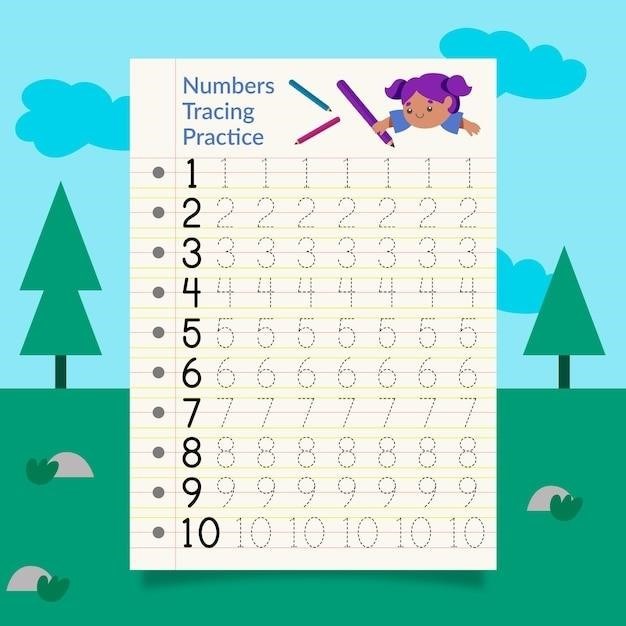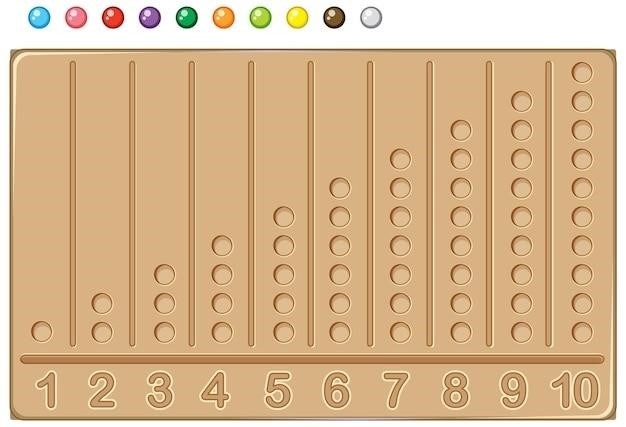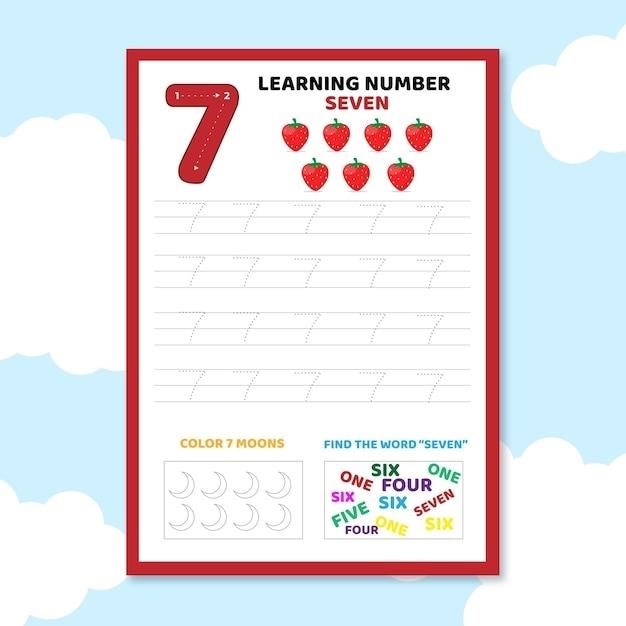Understanding Inequalities
Inequalities are mathematical statements comparing two expressions, showing that one is greater than, less than, greater than or equal to, or less than or equal to the other. These relationships are represented using symbols⁚ <, >, ≤, ≥. Number lines provide a visual way to represent the solution sets of inequalities, showing all possible values that satisfy the inequality. Worksheets offer practice in solving and graphing these inequalities.
Types of Inequalities
Inequalities are classified into several types based on the relationship they express. One-step inequalities involve a single operation (addition, subtraction, multiplication, or division) to isolate the variable. Two-step inequalities require two operations to solve for the variable. Compound inequalities combine two or more inequalities using “and” (intersection) or “or” (union) to represent a range of values. These can be shown on number lines as overlapping or separate intervals. Linear inequalities involve variables raised to the first power only. Nonlinear inequalities have variables raised to powers other than one, such as quadratic inequalities involving x². Understanding these classifications is crucial for selecting the appropriate solving and graphing techniques, often practiced through worksheets featuring a mix of inequality types.
Representing Inequalities on a Number Line
Number lines offer a visual method for representing the solution sets of inequalities. A number line is a horizontal line with evenly spaced numbers. To graph an inequality, locate the critical value (the number involved in the inequality) on the number line. If the inequality includes “or equal to” (≤ or ≥), use a closed circle (●) to indicate that the critical value is included in the solution. If the inequality is strict (< or >), use an open circle (○) to show the critical value is not part of the solution. Then, shade the number line to show all values satisfying the inequality; shade to the right for “greater than” and to the left for “less than.” For compound inequalities, the number line shows the intersection or union of the solutions, depending on whether it’s an “and” or “or” statement. Worksheets often include exercises requiring students to represent inequalities graphically on number lines, reinforcing their understanding of solution sets.

Solving Inequalities
Solving inequalities involves finding the range of values that satisfy the given inequality. This often requires applying inverse operations, similar to solving equations, but with careful consideration of inequality symbols.
One-Step Inequalities
One-step inequalities involve a single operation (addition, subtraction, multiplication, or division) separating the variable from the constant. Solving them requires performing the inverse operation on both sides of the inequality to isolate the variable. Remember to reverse the inequality sign if multiplying or dividing by a negative number. For example, to solve x + 5 < 10, subtract 5 from both sides, resulting in x < 5. Similarly, solving 2x ≥ 6 involves dividing both sides by 2, yielding x ≥ 3. Graphing the solution on a number line involves placing a closed circle (inclusive) or an open circle (exclusive) on the critical value and shading the line in the direction indicated by the inequality symbol. Worksheets often include a variety of these types of problems to build understanding and proficiency. Practice with these problems reinforces the fundamental concepts before moving on to more complex scenarios. The number line provides a visual representation, making it easier to grasp the solution set.
Two-Step Inequalities
Two-step inequalities require two operations to isolate the variable. These problems build upon the foundation of one-step inequalities, combining two inverse operations. For instance, consider the inequality 3x + 7 ≤ 16. First, subtract 7 from both sides to get 3x ≤ 9. Then, divide both sides by 3, resulting in x ≤ 3. Remember the rule⁚ when multiplying or dividing by a negative number, reverse the inequality symbol. For example, if you have -2x + 4 > 10, subtract 4 from both sides to get -2x > 6. Then, divide by -2 and reverse the inequality sign to obtain x < -3. Graphing these solutions on a number line uses the same principles as one-step inequalities⁚ closed circles for inclusive inequalities (≤, ≥) and open circles for exclusive inequalities (<, >), followed by shading the appropriate region. Practice worksheets provide numerous examples to master this essential skill.

Graphing Inequalities
Visualizing inequality solutions on a number line is crucial. Open and closed circles represent whether the endpoint is included, and shading indicates the solution set’s direction. Worksheets help solidify this graphical representation.
Open and Closed Circles
When graphing inequalities on a number line, the use of open and closed circles is essential to accurately represent the solution set. An open circle, or hollow dot (◦), indicates that the endpoint is not included in the solution. This is used for inequalities with < (less than) or > (greater than) symbols, signifying that the value at the endpoint does not satisfy the inequality. Conversely, a closed circle, or filled-in dot (•), signifies that the endpoint is included in the solution. This is utilized for inequalities with ≤ (less than or equal to) or ≥ (greater than or equal to) symbols, meaning the endpoint value satisfies the inequality. The choice between an open or closed circle is critical for precisely representing the solution set on the number line, making it a key aspect of understanding and solving inequalities. Properly identifying and using these symbols ensures accurate graphical representation of the inequality’s solution. Worksheets often include practice problems focusing on this crucial distinction between open and closed circles to reinforce the understanding of inequality notation and its graphical interpretation.
Shading the Number Line
Shading the number line is a visual method used to represent the solution set of an inequality. After plotting the endpoint(s) with the appropriate open or closed circle, the number line is shaded to indicate all values that satisfy the inequality. For inequalities like x > 3, the number line is shaded to the right of 3, illustrating all values greater than 3. Similarly, for x < 3, shading occurs to the left of 3, showing values less than 3. In inequalities involving “or equal to” (≤ or ≥), the endpoint is included in the shaded region, indicated by a closed circle. When graphing compound inequalities, such as 2 < x < 5, the shading occurs between the two endpoints (2 and 5), representing all values greater than 2 and less than 5. The direction of the shading always corresponds to the inequality symbol, ensuring the graphical representation accurately reflects the solution set. Worksheets often utilize this technique, providing practice in accurately shading the number line to represent the solution set of various inequalities, reinforcing the connection between algebraic inequalities and their graphical interpretations.
Practice Worksheets
Numerous online resources and textbooks offer printable worksheets with diverse inequality problems. These range from simple one-step inequalities to more complex multi-step problems, providing ample practice for students of all levels.
Examples of Inequality Problems
Inequality problems on worksheets often involve solving for a variable within an inequality statement. A typical example might be⁚ “Solve 3x + 5 < 14 and graph the solution on a number line.” This requires students to isolate ‘x’ using algebraic manipulation (subtracting 5 from both sides, then dividing by 3), resulting in x < 3. The number line representation would show an open circle at 3 and shading to the left, indicating all values less than 3 are solutions. More complex problems might feature compound inequalities (like -2 < x ≤ 4), requiring the student to represent a range of values on the number line using both an open and a closed circle. Word problems also appear frequently, requiring students to translate real-world scenarios into mathematical inequalities before solving and graphing. For instance, a problem could state⁚ “A student needs at least 80 points on a test to pass. If they already have 55 points, how many more points do they need?” This translates into the inequality 55 + x ≥ 80, solvable through subtraction and number line graphing.
Resources for Printable Worksheets
Numerous online resources provide free printable worksheets focusing on inequalities and number lines. Websites like Kuta Software LLC offer customizable worksheets with varying difficulty levels, allowing educators to tailor practice to their students’ needs. These often include answer keys for easy grading. Educational platforms such as Math-Drills.com and MathWorksheets4Kids.com also provide a wide selection of printable worksheets covering various aspects of inequalities, from basic one-step problems to more complex multi-step inequalities and compound inequalities. These resources frequently incorporate word problems to enhance real-world application understanding. Additionally, many textbook websites offer supplementary printable resources, often aligning with specific textbook chapters or sections. Searching for “inequalities worksheets PDF” on a search engine will also yield many relevant results from various educational websites and blogs. Remember to preview the worksheet before printing to ensure it aligns with your specific curriculum requirements and student skill levels.
